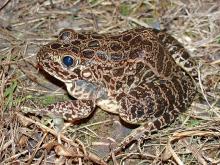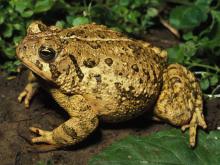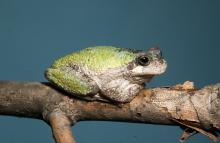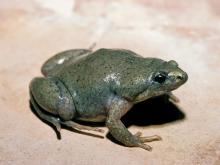Reptiles and Amphibians
Media

Species Types
Scientific Name
Pantherophis ramspotti
Description
The western foxsnake is a moderately large snake with distinct brown blotches. In Missouri, it is rare and found only in our far northwestern counties.
Media

Species Types
Scientific Name
Agkistrodon contortrix
Description
The eastern copperhead is the most common venomous snake in Missouri. Its color varies from grayish brown to pinkish tan, with distinctive hourglass-shaped crossbands.
Media

Species Types
Scientific Name
Nerodia sipedon sipedon (northern watersnake) and N. s. pleuralis (midland watersnake)
Description
The northern watersnake and midland watersnake are Missouri's two subspecies of common watersnake. Together they occur statewide. Color is variable: gray, tan, or reddish brown with dark crossbands or blotches. The belly is cream-colored with red, brown, or black spots or half-moon markings.
Media

Species Types
Scientific Name
Coluber constrictor flaviventris (eastern yellow-bellied racer) and Coluber constrictor priapus (southern black racer)
Description
The eastern yellow-bellied racer is uniformly tan, brown, olive, blue, gray, or nearly black on top, with a yellow, cream, or light blue-gray belly. It occurs nearly statewide. The southern black racer subspecies also lives in the southeastern half of the state.
Media

Species Types
Scientific Name
Lithobates areolatus circulosus
Description
A very secretive species, the northern crawfish frog spends most of its time hidden burrows, typically those made by crayfish. It is restricted to native prairie or former prairie areas and is a species of conservation concern in Missouri.
Media

Species Types
Scientific Name
Anaxyrus americanus (formerly Bufo americanus)
Description
American toads are well-known and occur statewide. Missouri has two subspecies: the eastern American toad in the northern half, and the dwarf American toad in the southern half.
Media

Species Types
Scientific Name
Hyla versicolor (Gray Treefrog) and Hyla chrysoscelis (Cope's Gray Treefrog)
Description
Sticky pads on fingers and toes enable Missouri's two gray treefrogs to climb and rest on vertical surfaces. You might occasionally see one resting on the siding of your house, if you live near suitable treefrog habitat.
Media

Species Types
Scientific Name
Pseudacris maculata
Description
More often heard than seen, the boreal chorus frog calls with a vibrating “prrreeep” that rises in pitch at the end. It lasts one or two seconds and sounds like a fingernail scratched over the teeth of a pocket comb. It occurs nearly statewide, except for the southeastern quarter.
Media

Species Types
Scientific Name
Gastrophryne olivacea
Description
The western narrow-mouthed toad has a plump body, short legs, uniform color, small, pointed head, and a fold of skin across the back of the head. The general color is gray, tan, or olive tan. In our state is is reported from far western Missouri and east along the Missouri River as far as the center of the state.
Media

Species Types
Scientific Name
Anaxyrus cognatus
Description
Unlike other true toads in Missouri, the Great Plains toad has a raised hump between the eyes on the snout. Look for it along the Missouri River floodplain, from the Iowa border to about Hermann.
See Also
About Reptiles and Amphibians in Missouri
Missouri’s herptiles comprise 43 amphibians and 75 reptiles. Amphibians, including salamanders, toads, and frogs, are vertebrate animals that spend at least part of their life cycle in water. They usually have moist skin, lack scales or claws, and are ectothermal (cold-blooded), so they do not produce their own body heat the way birds and mammals do. Reptiles, including turtles, lizards, and snakes, are also vertebrates, and most are ectothermal, but unlike amphibians, reptiles have dry skin with scales, the ones with legs have claws, and they do not have to live part of their lives in water.





















